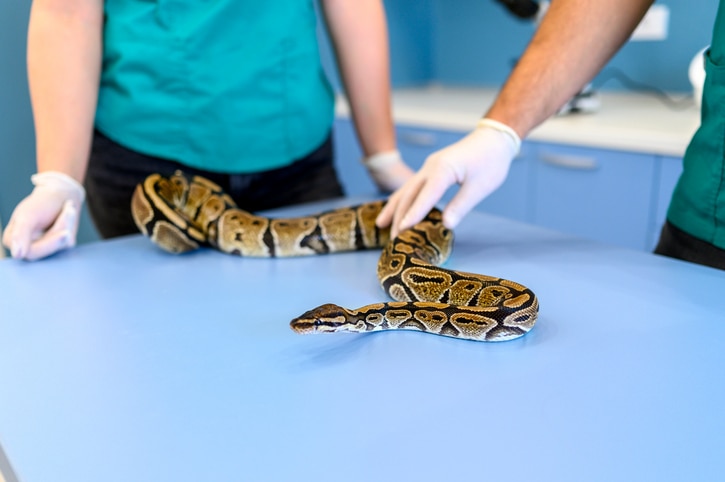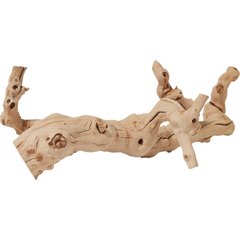How Long Do Snakes Live? Tips to Improve Your Pet Snake’s Lifespan

Photo by dardespot/E+ via Getty Images Plus
Snakes are among the world’s most interesting creatures, and with over 4,000 species worldwide in every color imaginable, it’s no surprise. These unique reptiles make terrific pets, but pet parents often wonder about the lifespan of their scaly pal—with one of the most common questions among snake keepers being “how long do snakes live?”
Because snakes can have slightly different lifespans, depending on lifestyle, diet, and species, there is no single answer. However, every snake’s lifespan can be maximized with good care, including proper diet and habitat.
How Long Can a Snake Live?
Depending on their species, most pet snakes live 15–20 years. A snake’s lifespan varies according to their species, with dramatic changes in life expectancy.
Garter snakes are one of the shortest-lived species, while pythons can live very long lives. For example, a pet ball python can live over 30 years.
In the wild, that same snake may only live for a few months or years. Wild snakes live dangerously; they hunt for food while trying to avoid becoming food for another animal. Smaller snakes tend to have shorter lives than bigger species because they have more predators. In addition, they can’t go as long without food and must eat more often.
| Common Pet Snake Species | Average Lifespan in Captivity |
|---|---|
| Ball python | 20–30 years |
| California kingsnake | 20–30 years |
| Corn snake | 15–20 years |
| Emerald tree boa/Amazon basin boa | 15–20 years |
| Garter snake | 8–10 years |
| Gopher snake | 20–30 years |
| Green tree python | 15–20 years |
| Hognose | 15–18 years |
| Kenyan sand boa | 15–20 years |
| Rat snakes | 20–30 years |
| Red-tail boa/boa constrictor | 20–30 years |
| Reticulated python | 30–40 years |
| Rosy boa | 20–30 years |
What Affects a Snake’s Lifespan?
Aside from their species, the biggest indicators of how long a snake can live are their lifestyle and diet.
The best things you can do to make sure your pet snake lives a long, healthy life are to provide:
Quality Food
Your pet snake’s needs will change as they grow. Everything from the size or species of their food to their enclosure will have to change with them.
Your pet snake doesn’t need to hunt down their own meal or defend themselves against predators, but they have the same needs as their wild cousins. To maximize your pet snake’s lifespan, feed them nutritious, species-appropriate foods.
However, unless your vet recommends it, don’t feed your snake live food. Most experienced keepers prefer feeding frozen/thawed prey because it’s safer for the snake and less stress for the prey animal.
Live prey fights back and can hurt your snake, leading to expensive veterinary visits and sometimes a severely injured snake. In extreme cases, a rat can kill a snake.
An Enclosure Appropriate for the Species
Pet snakes need enclosures big enough for them to move around and display normal behavior. Some species need more space than others, so be sure to talk to your vet and research your snake’s species.
A high-quality enclosure includes things your snake might find in their natural habitat—minus the danger—including products like the Frisco Artificial Garland Terrarium Vine and the Frisco Reptile Natural Grapevine Branch.
Recommended Products
Regular Veterinary Care
Snakes should be seen by a veterinarian shortly after adoption for an initial visit. After that, pet snakes should be seen annually for preventative care.
Stress, illness, and injury can shorten your pet snake’s life. Fortunately, a clean enclosure with proper heating, UV lighting, humidity, and decor will help prevent most problems.
How To Help Your Pet Snake Live Longer
Although they are often overlooked, enrichment opportunities can also help your snake live a healthier life. If your snake tolerates a bit of handling, get them out of their enclosure periodically.
Take your pal to a safe location, away from other animals, with different textures and a few climbing opportunities. They’ll get mental stimulation and exercise, while you can get a good look at their body condition and spot potential problems.
Of course, never leave your pet snake unsupervised while they roam.
Other tips to help your snake live as long as possible include:
- Setting up a safe enclosure with opportunities for climbing, burrowing, or exploring
- Providing prey items of the right size and species for your snake
- Providing clean water in a dish big enough that your snake can soak if they want
- Maintaining their enclosure humidity at the right levels for your snake species
- Ensuring enclosure decorations do not have sharp edges they can hurt themselves on
- Keeping a first-aid kit for your pal that includes tweezers, provo-iodine, and an electrolyte soak like the Zoo Med Electrolyte Reptile Soak
- Offering appropriate enrichment activities, depending on your snake’s species
- Providing regular veterinary care with an experienced exotic vet
Recommended Product
Unsure whether your pal needs a vet visit?
The following scenarios are considered emergencies. Immediately take your pet snake to the vet if they:
- Make wheezing sounds or have bubbles from their mouth or nostrils
- Have a prolapsed rectum (male or female) or a prolapsed hemipene, one of a pair of male reproductive organs in snakes
Other scenarios that warrant a trip to the vet include:
- Regurgitating food during or after more than two successive feedings
- Diarrhea (this is not normal for reptiles)
- Your snake eats well but is too thin for the species
- Stuck shed (dysecdysis) that you can’t get loose
- Scales look discolored or damaged, showing a possibility of scale rot
- Thermal burns from an under-tank heater or rubbing against a heat lamp
When reptiles are hurt or sick, their conditions can quickly worsen. So if you suspect your scaly friend is ill, make an appointment with their vet right away.
On the other hand, by providing a healthy, safe environment with nutritious food, your pet snake can have a lifespan double that of their wild cousins. By following the tips above and choosing the snake species right for you, you’ll likely have a longtime friend!
This article was medically reviewed by Melissa Witherell, DVM, Chewy veterinarian.






